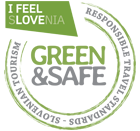The requested page does not exist
Mogoče iščete ...
Hiking
The Tower of Love on Žusem
The Tower of Love on Žusem is located on the north-eastern part of Veliki špiček (669 m), the highest point on Žusem, representing the northern edge of the Kozjansko region.
The idea of setting up a 25.90 m-high outlook tower from larch wood, which is the highest wooden tower in Slovenia, arose in the Žusem Mountaineering Association some time ago. The tower was named “The Tower of Love” because a church consecrated to St. Valentine, the patron saint of lovers, is located ...






